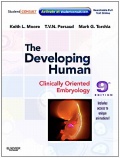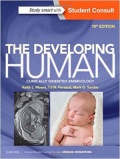BGDA Tutorial - Embryology
| Embryology - 28 Apr 2024 |
|---|
| Google Translate - select your language from the list shown below (this will open a new external page) |
|
العربية | català | 中文 | 中國傳統的 | français | Deutsche | עִברִית | हिंदी | bahasa Indonesia | italiano | 日本語 | 한국어 | မြန်မာ | Pilipino | Polskie | português | ਪੰਜਾਬੀ ਦੇ | Română | русский | Español | Swahili | Svensk | ไทย | Türkçe | اردو | ייִדיש | Tiếng Việt These external translations are automated and may not be accurate. (More? About Translations) |
Introduction
This online tutorial is an opportunity for students to raise with the Embryology content provider any specific topics that have not been resolved in either the Lecture or Practical classes. BGDA embryology structure has been designed to take you through human development at a greater depth than the introduction made in Foundations.
It has identified the sequence of events from reproductive cycles, fertilization, implantation, placentation, embryonic and fetal development. (note we have not yet covered the metal and placental development content)
2017
| Practical 3 - Fertilization to Implantation | Practical 6 - Implantation to 8 Weeks | Practical 12 - Fetal Period |
BGDB will follow on by covering specific systemic development issues.
My answers and those of the other expert tutors refer specifically only to Embryology content and not that of other disciplines.
2014
Expert Tutorial Issues
Be prepared for your tutorials. It does not help anyone if you have no questions to bring to the table, and turns an opportunity for interaction into a straight review lecture.
Look through your own lecture and practical notes.
|
Discuss with you SG.
|
Be careful of inaccurate reporting.
|
Occasionally corrections are made to previously presented materials.
|
2014 BGD Cycle A
Questions
My answers specifically refer only to Embryology content that I have provided and not that of other disciplines.
Will this be in the Exam?
- Don't even try this one!
- I am happy to help you with my materials but not to simply narrow down the topics to those examined.
- In both Lectures and Practicals, the online content I work through with you is the basis of the concepts you need to know.
- External links are often to images, texts or references that should help your understanding of the content I provide, but are not directly examinable.
- Internal links to other specific content pages are similarly for aiding the understanding of specific concepts.
- Internal links to animations are used to illustrate dynamic processes that are also generally described on the content pages.
- Additional Information on Practical class pages is just that, and does not form part of the current assessment content.
Abnormal Development
Australia - Top 10
The ten most frequently reported birth defects in Victoria between 2003-2004.
- Hypospadias
- Obstructive Defects of the Renal Pelvis or Obstructive Genitourinary Defects
- Ventricular Septal Defect
- Congenital Dislocated Hip
- Trisomy 21 or Down syndrome
- Hydrocephalus
- Cleft Palate
- Trisomy 18 or Edward Syndrome - multiple abnormalities of the heart, diaphragm, lungs, kidneys, ureters and palate 86% discontinued.
- Renal Agenesis/Dysgenesis - reduction in neonatal death and stillbirth since 1993 may be due to the more severe cases being identified in utero and being represented amongst the increased proportion of terminations (approximately 31%).
- Cleft Lip and Palate - occur with another defect in 33.7% of cases.
- Links: ACAMS | Australian Statistics
USA - Selected
| USA Statistics | ||||||||||||||||||||||||||||||||||||||||||||||||||||||||||||||||||||||||
|---|---|---|---|---|---|---|---|---|---|---|---|---|---|---|---|---|---|---|---|---|---|---|---|---|---|---|---|---|---|---|---|---|---|---|---|---|---|---|---|---|---|---|---|---|---|---|---|---|---|---|---|---|---|---|---|---|---|---|---|---|---|---|---|---|---|---|---|---|---|---|---|---|
| ||||||||||||||||||||||||||||||||||||||||||||||||||||||||||||||||||||||||
- Links: USA Monitoring Programmes | USA Statistics
Textbooks
In addition to the online topic pages, there are excellent embryology textbooks and I have included links to "The Developing Human" that also cover the clinical topics. this textbook is accessible through the UNSW Library by students. The links below will require you to firstly log-in and then you will have assess to the full textbook. More Textbooks?

|
Citation: Moore, K.L., Persaud, T.V.N. & Torchia, M.G. (2011). The developing human: clinically oriented embryology (9th ed.). Philadelphia: Saunders.
Links: NLM ID: 101293798 | publisher page | NLM Holding
|
- Links: More Embryology Textbooks
Embryology 2011 Tutorial Audio
These are a live unedited recording from the two 2011 repeat tutorials and may contain errors in either descriptions or content. These recordings are for University level students and may not be suitable for young students. For educational purposes only.
- Dr Mark Hill Monday 23rd May 2011 11am Biomed E listen | download (5.83 Mb MP3 50:56)
- Dr Mark Hill Monday 24th May 2011 11am Biomed E listen | download (5.31 Mb MP3 46:23)
For educational purposes only.
2011
This page also includes links to an earlier 2011 audio recordings made from the first tutorial sessions.
--Mark Hill (talk) 10:30, 25 May 2015 (AEST)
BGDA: Lecture 1 | Lecture 2 | Practical 3 | Practical 6 | Practical 12 | Lecture Neural | Practical 14 | Histology Support - Female | Male | Tutorial
Glossary Links
- Glossary: A | B | C | D | E | F | G | H | I | J | K | L | M | N | O | P | Q | R | S | T | U | V | W | X | Y | Z | Numbers | Symbols | Term Link
Cite this page: Hill, M.A. (2024, April 28) Embryology BGDA Tutorial - Embryology. Retrieved from https://embryology.med.unsw.edu.au/embryology/index.php/BGDA_Tutorial_-_Embryology
- © Dr Mark Hill 2024, UNSW Embryology ISBN: 978 0 7334 2609 4 - UNSW CRICOS Provider Code No. 00098G



